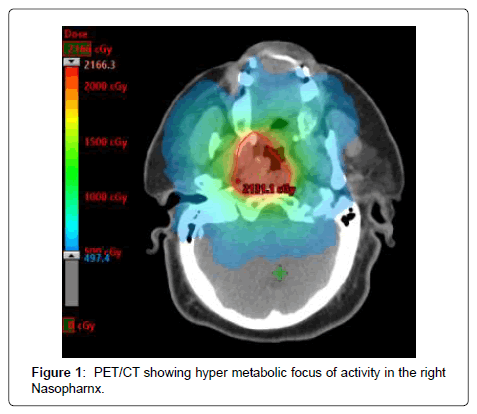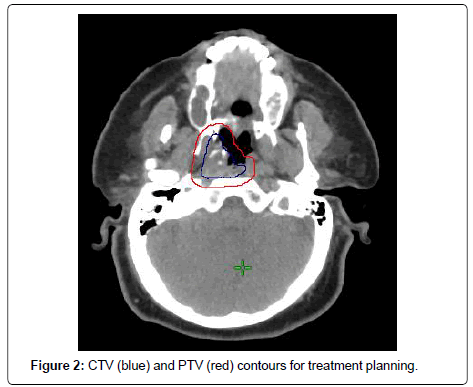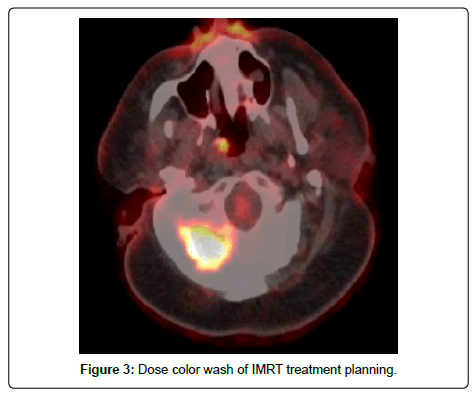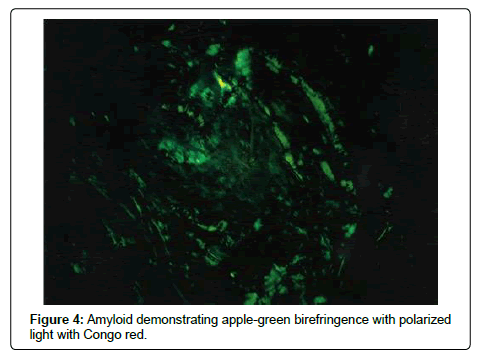Case Report, Clin Oncol Case Rep Vol: 2 Issue: 1
Localized Amyloidosis of the Nasopharnx, a Role for Modern Radiotherapy, a Case Report and Literature Review
Matthiesen C1*, Mc Clintick S2 and Bruggen AJ2
1Department of Radiation Oncology, Cornell-Beshore Cancer Institute/Freeman Health System 1102 West 32nd Street Joplin, USA
2Department of Otorhinolaryngology, Cornell-Beshore Cancer Institute/Freeman Health System Head and Neck Surgery, 1102 West 32nd Street Joplin, USA
*Corresponding Author : Chance Matthiesen
Cornell-Beshore Cancer Institute/ Freeman Health System, Department of Radiation Oncology Department of Otorhinolaryngology, 1102 West 32nd Street Joplin, USA
Tel: +417-347-2200
E-mail: clmatthiesen@freemanhealth.com
Received: November 13, 2018 Accepted: February 05, 2019 Published: February 12, 2019
Citation: Matthiesen C, Mc Clintick S, Bruggen AJ (2019) Localized Amyloidosis of the Nasopharnx, a Role for Modern Radiotherapy, a Case Report and Literature Review. Clin Oncol Case Rep 2:1.
Abstract
Amyloidosis is a rare condition. Focal deposition of amyloid has been known to occur in many tissues of the body. In this report, we present a report of localized amyloidosis presenting within the nasopharynx. Treatment utilized included a combination of initial surgical resection followed by salvage radiotherapy at recurrence. Utilization of modern radiotherapy technique intensity modulated radiation therapy (IMRT) was performed. A review of the literature is performed and presented for discussion.
Keywords: Amyloidosis; IMRT; Radiation therapy; Nasopharnx
Introduction
Amyloidosis is a condition characterized by deposition of amyloid, a fibrillary substance consisting of low-molecular weight proteins [1]. It can present as localized disease, implying its restriction to any solitary organ in the body, or as a systemic disorder [1]. Localization of the disease in the nasopharynx is very rare, and therefore the optimal management is unknown [2]. Given the difficulty of surgical access and gross total resection (GTR) in the nasopharynx, treatment with surgery alone has been known to result in recurrence [3,4] Studies have examined the use of single and multi-modality therapy for focal amyloidosis including surgery, systemic therapy, and radiotherapy [4]. In this report, we present a case of focal amyloidosis recurrence within the nasopharynx treated with salvage radiotherapy.
Case Report
A 55 year old male presented with epistaxis for several months. Computed tomography (CT) scans of the head and neck showed a right lateralized nasopharyngeal mass. Evaluation by an ear-nosethroat (ENT) physician confirmed an abnormal mass in the right nasopharynx, and biopsy showed the mass consistent with amyloid. Sub-total resection (STR) was performed and pathology confirmed amyloid deposition without further findings. Follow-up CT scans 6 months after resection confirmed recurrence and progression of the mass. He was then referred to consider radiotherapy.
A positron emission tomography (PET)/CT scan was performed initially to aid in tumor localization; this is illustrated in (Figure 1). The patient was simulated supine and immobilization was performed utilizing a thermoplastic mask. A clinical tumor volume (CTV) was contoured in the treatment planning system, and this volume was expanded 5 mm circumferentially to generate the planning target volume (PTV) as illustrated in (Figure 2). Treatment was performed utilizing intensity modulated radiation therapy (IMRT). Dose prescription was 200 cGy per fraction times 10 fractions, for a total dose of 20 Gy. Treatment plan with dose coverage is shown in (Figure 3). Treatment was delivered as planned, and no acute or late toxicities were reported. Follow-up from date of treatment was 18 months. No recurrence of disease has been found (Figure 4).
Discussion
Primary localized amyloidosis is an uncommon condition [4]. It is possible for amyloid deposition to occur in any tissue of the body [1]. GTR for lesions surgically accessible is the most common treatment when applicable [3,4].The use of adjuvant or definitive radiation therapy is also known to be of clinical benefit, with varying doses reported in the literature [2,5,6].
Amyloidosis in the nasopharynx presents a surgical challenge in the ability to achieve a gross total resection [2-4]. The use of surgery with adjuvant radiation has been documented before in the Nasopharnx [2]. The use of salvage radiotherapy for amyloidosis in other organs is also documented, both with favorable outcomes [7]. The most common location of localized amyloidosis managed with definitive radiotherapy is the trachea, with doses of 20-24 Gy delivered in 10-12 fractions with minimal recurrences [5,6,8-11].
Conclusion
Radiotherapy is useful in the management of focal amyloidosis in the nasopharynx. It should be considered in all cases when sub-total resection is achieved as adjuvant therapy. Definitive therapy is also a consideration for non-operable patients, but needs further investigation. The dose of 20 Gy in ten fractions presents as a reasonable therapeutic ratio.
References
- Kumar V, Abbas AK, Faustro N (2005) Robbins and Cotran Pathologic Basis of Disease, (7th edn). Pennsylvania: Philadelphia: Elsevier Saunders 258-261.
- Luo M, Peng G, Shi L (2016) Intensity-modulated radiotherapy for localized nasopharyngeal amyloidosis: Case report and literature review. Strahlenther Onkol 192: 944-950.
- Chowsilpa S, Chaiyasate S, Wannasai K, Daroontum T (2018) Localized nasopharyngeal amyloidosis: the importance of postoperative follow-up. BMJ Case Rep 2017-2020.
- Sanchez LE, Cervera OC, Guerrero CR (2013) Amyloidosis of the Nasopharnx. Acta Otorrinolaringol 64: 377-378.
- Truong MT, Kachnic LA, Grillone GA (2012) Long-term results of conformal radiotherapy for progressive airway amyloidosis. Int J Radiat Oncol Biol Phys 83: 734-739.
- Monroe A, Walia R, Zlotecki R (2004) Tracheobronchial amyloidosis: a case report of successful treatment with external beam radiation therapy. Chest 125: 784-789.
- Cooper TC, Greene BD, Fegan JE (2018) External beam radiation therapy for amyloidosis of the urinary bladder. Pract Radiat Oncol 8: 25-27.
- Neben-Wittich MA, Foote RL, Kalara S (2007) External beam radiation therapy for tracheobronchial amyloidosis. Chest 132: 262-267.
- Kalra S, Utz JP, Edell ES (2001) External-beam radiation therapy in the treatment of diffuse tracheobronchial amyloidosis. Mayo Clinic Proc76: 853-856.
- Thompson DR, Lester (2000) Amyloid demonstrating apple-green birefringence with polarized light with Congo red.
- Kurrus JA, Hayes JK, Hoidal JR (1998) Radiation therapy for tracheobronchial amyloidosis. Chest 114: 1489-1492.
 Spanish
Spanish  Chinese
Chinese  Russian
Russian  German
German  French
French  Japanese
Japanese  Portuguese
Portuguese  Hindi
Hindi 



